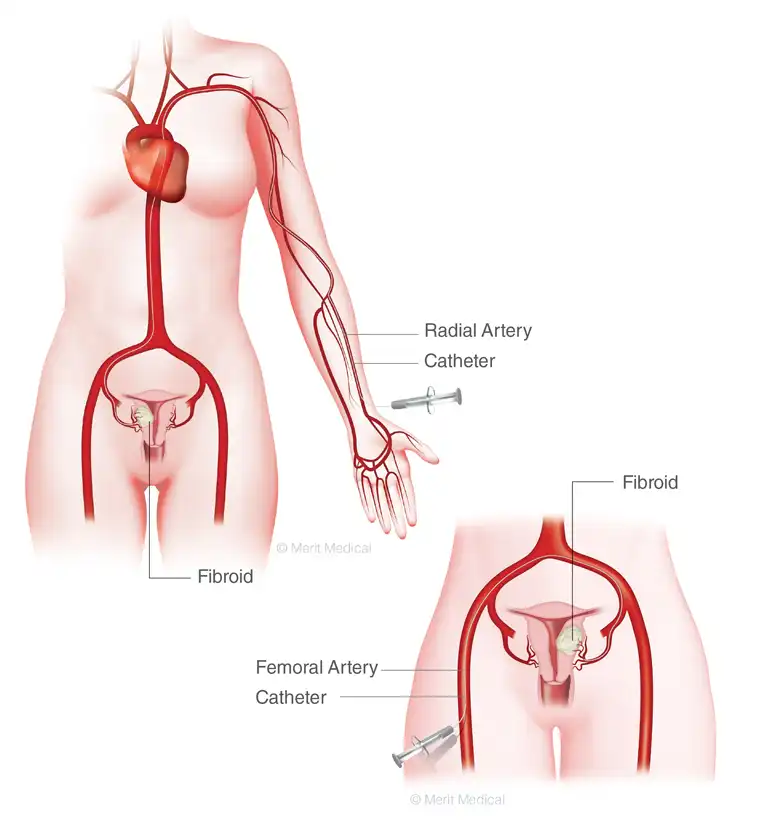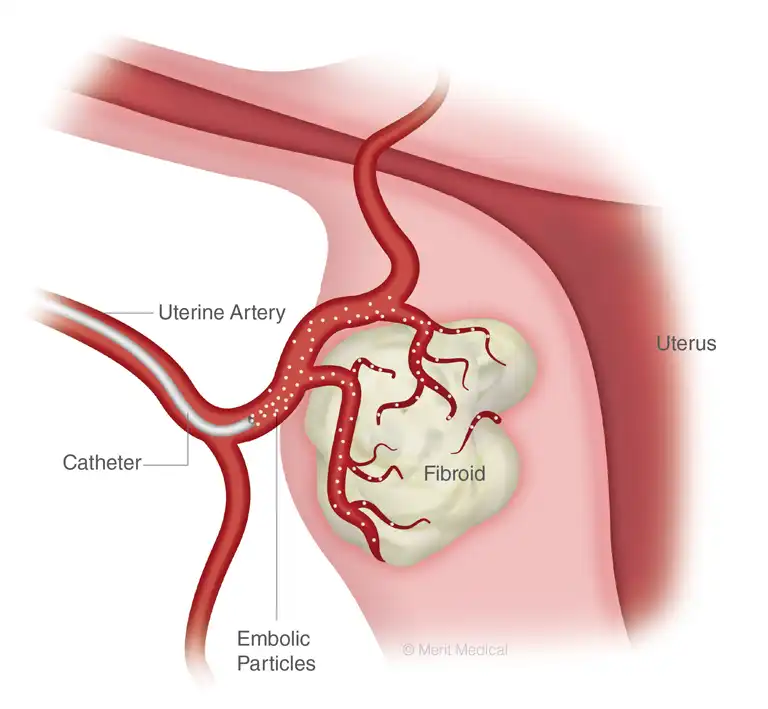Many women choose UFE for a variety of reasons. If you’re interested in learning more about UFE, request an appointment with one of our fibroid specialists.
What Is Trans-Radial UFE?
Dr. Balfour, Dr. Pruett, and Dr. Tower offer a unique approach to the UFE procedure using trans-radial access. This state-of-the-art technique allows the procedure to be performed through the radial artery in the left wrist. Trans-radial access is an advanced treatment option that has fewer complications and less pain than the more commonly performed UFE treatment option that utilizes the femoral artery in the groin. Trans-radial access also allows patients to sit upright or walk immediately following thir UFE treatment, and has been proven to increase patient comfort and lead to faster recovery.
Read below to learn more about the entire UFE procedure. Request an appointment with Fresno Fibroid Center using our online form, or call (559) 436-4737.
UFE Treatment
Once you and your doctors(s) have determined that Uterine Fibroid Embolization (UFE) is the right fibroid treatment option for you, here are some of the things you’ll need to know before, during and after treatment.
BEFORE TREATMENT | UFE TREATMENT | AFTER TREATMENT
Before Treatment
Your Interventional Radiologist (IR) will explain to you in detail all of the pre-procedure tests prescribed. Also during your consult, you should let your doctor know if you are allergic to any medications, shellfish, iodine, contrast agents, or gelatin to minimize the risk of a reaction as a result of the fibroid treatment procedure. You and your doctor also should decide what type of sedation will work best for you. Most doctors use conscious sedation, which means you will be awake during the procedure but you will feel groggy.
UFE is performed as an outpatient fibroid treatment procedure and patients are usually able to go home the same day. After you arrive for your treatment, you will be prepped for the procedure by the staff. This includes initiating sedation and other medication discussed during your consult. Other medications to help manage post-procedure effects may also be administered at this time. It is important to discuss with your IR which medications will be used in the management of your post-procedure care. While groggy or sleepy the fibroid treatment will be performed in the interventional suite.
Uterine Fibroid Embolization Treatment

Uterine fibroid embolization, also known as uterine artery embolization is a minimally invasive procedure that is performed by an Interventional Radiologist (IR), a medical doctor with extensive experience in minimally invasive procedures. Prior to the procedure, some tests may have to be done. The entire fibroid treatment typically lasts around 1-2 hours, and is performed as an outpatient therapy going home the same day. Rarely, patients are observed for up to 23 hours after the procedure is complete.
The uterine fibroid embolization procedure begins with a tiny incision over the femoral artery in the upper thigh or over the radial artery in the left wrist. This provides the IR with access to the arterial system. Using specialized X-ray equipment, the IR passes a catheter (small tube) through the arteries to the uterine artery, and guides it near the location of the fibroid tumor. When the IR has reached the location of the fibroids, embolic material (small spheres) are injected through the catheter and into the blood flow leading to the uterine fibroid tumors.
The embolic material is designed to block the vessels around the fibroid, depriving it of the blood and oxygen it needs to grow. The blood and oxygen deprivation results in fibroids shrinking. The embolic material remains permanently in the blood vessels at the fibroid site. This kind of embolization procedure can permanently block blood flow the the tumors while allowing blood flow to return to the normal uterus.

The catheter is then moved to the other side of the uterus, usually using the same entry point to the arterial system. Once the IR has completed embolization of the uterine artery on both sides, the catheter is gently removed and the IR places finger pressure over the access site. For upper thigh access a vascular closure device may also be used to help reduce the risk of bleeding. For left wrist access, a small pressure balloon is used to hold pressure on the artery for a short period during recovery.
After the procedure, you may experience some discomfort such as abdominal cramping or pain. You and your doctor will determine what medications may be needed to keep you comfortable. The post-procedure care that you receive will be administered by skilled nurses and your IR. Post procedure appointments will need to be scheduled, and since these appointments vary, be sure to ask your IR when they need to be scheduled.
After Treatment
Most women experience some degree of abdominal pain or cramping (similar to menstrual cramps) shortly after this treatment for uterine fibroids. Your doctor will decide what medications you will need to keep you comfortable. Generally patients receive medications for pain management at home. Occasionally a patient experiences fever, which is usually treated with medication. Some patients experience nausea related to medications and anti-nausea medication is provided or the medications may be changed accordingly. In rare cases, you could remain under observation for up to 23 hours, depending upon the decision of your physician.
Some patients may experience “post-embolization syndrome” following the uterine fibroid treatment which is described as having flu-like symptoms, such as a low grade fever, malaise (a vague feeling of discomfort), and mild nausea. Post-embolization syndrome can occur within a few hours or up to a few days after uterine fibroid embolization.
Once your IR has evaluated you and has decided you are ready for discharge, you will receive discharge instructions from your doctor. These instructions include information on post uterine fibroid treatment care regarding medications you will need to take to keep you comfortable based on how you are feeling. They may also include information on when you can expect to begin returning to normal activities, as well as all phone numbers for whom to call if you have questions. You may continue to experience some cramping, similar to menstrual period cramping, that lasts a few days after the procedure. Most women are able to return to light activity within a few days of the uterine fibroid embolization treatment and are usually back to work within 1 week. On average, post-procedure discomfort completely resolves within 11 days.
Finally, your IR will schedule your post-procedure appointments to check your recovery. Typical timeframes for these appointments are 1 week post-procedure, and 3 months post-procedure. Since follow up appointments do vary, be sure to ask when these appointments should be scheduled.
© 2003-2015 Merit Medical Systems, Inc. All Rights Reserved.
